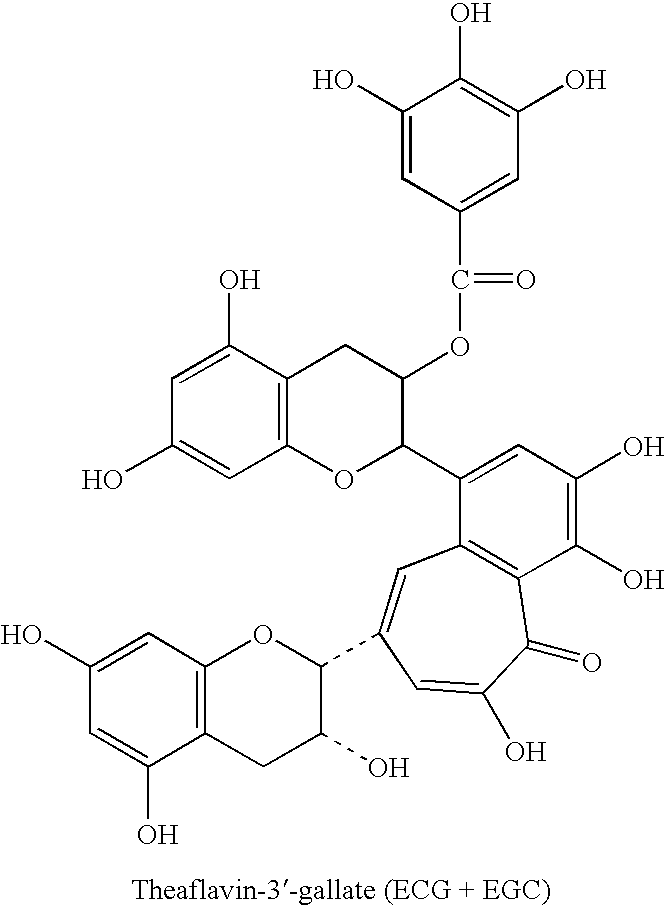Process of making theaflavins enriched tea extract
a technology of theaflavins and tea extract, which is applied in the field of making theaflavins enriched tea extract, can solve the problems of high cost of methods, inability to recover chemical reagents, and difficulty in purifying thearubigins, and achieves the effect of high theaflavins content and low conten
- Summary
- Abstract
- Description
- Claims
- Application Information
AI Technical Summary
Benefits of technology
Problems solved by technology
Method used
Image
Examples
example 1
Synopsis
[0044]This invention provides a novel method of making theaflavins enriched tea extract starting from fresh leaves of Camellia sinensis or green tea extracts. This novel method includes separation steps that reduce considerably the amount of thearubigins with high molecular weight. Thearubigins are the predominant compounds found in black tea with molecular weights ranging from 1,000 to 40,000. Thearubigins of high molecular weight are not as biologically active as theaflavins. Also, the color of theaflavin enriched tea extracts with a lower content of high molecular weight thearubigins is more suitable for application in food and beverages. The color of pure theaflavins is orange while the color of thearubigins ranges from brown to dark-brown. The separation steps also allow the use of ethyl alcohol as the organic solvent rather than ethyl acetate. Conventional methods of making theaflavins use ethyl acetate as the organic solvent. Because ethyl alcohol exhibits the lowest ...
application examples
AND RESULTS
Example 1
Treatment of the Starting Materials: Fresh Green Tea Leaves
[0061]1. Foreign matter and other impurities were removed from fresh tea leaves. Then, the fresh green tea leaves were washed and withered in a dry and weak light place for 8 h.[0062]2. The withered green tea leaves were crushed.
Tea Fermentation Process—Formation of Theaflavins and Thearubigins
[0063]1. The crushed leaves were put in a fermentation tank. Water was added in the tank in the amount of 3 times the volume of crushed tea leaves. Loquat juice was added in the tank in the amount of 0.5 times the volume of crushed green tea leaves. At temperature 35-45° C., pH=4.5, air was introduced. This natural fermentation process was maintained for 20 min.[0064]2. At the end of fermentation, the air flow was stopped and the temperature was raised to 100° C. rapidly and kept for 15 min. A solution of 95% ethanol was added to the tank and the entire mixture was stirred for 20 minutes. The ratio of 95% ethanol t...
example 2
Treatment of the Starting Materials: Fresh Green Tea Leaves
[0070]1. Foreign matter and other impurities were removed from fresh tea leaves. Then, the fresh green tea leaves were washed and withered in a dry, low-light environment for 10 h.[0071]2. The withered green tea leaves were crushed.
Tea Fermentation Process—Formation of Theaflavins and Thearubigins
[0072]1. The crushed leaves were put in a fermentation tank. Water was added in the tank in the amount of 5 times the volume of crushed tea leaves. Apple juice was added in the tank in the amount of 1.0 times the volume of crushed green tea leaves. At temperature 40° C., pH=5.0, air was introduced. This natural fermentation process was maintained for 30 min.[0073]2. At the end of fermentation, the air flow was stopped and the temperature was raised to 100° C. rapidly and kept for 20 min. A solution of 95% ethanol was added to the tank and the entire mixture was stirred for 30 minutes. The ratio of 95% ethanol to the initial mixture ...
PUM
| Property | Measurement | Unit |
|---|---|---|
| melting points | aaaaa | aaaaa |
| temperature | aaaaa | aaaaa |
| weight | aaaaa | aaaaa |
Abstract
Description
Claims
Application Information
 Login to View More
Login to View More - R&D
- Intellectual Property
- Life Sciences
- Materials
- Tech Scout
- Unparalleled Data Quality
- Higher Quality Content
- 60% Fewer Hallucinations
Browse by: Latest US Patents, China's latest patents, Technical Efficacy Thesaurus, Application Domain, Technology Topic, Popular Technical Reports.
© 2025 PatSnap. All rights reserved.Legal|Privacy policy|Modern Slavery Act Transparency Statement|Sitemap|About US| Contact US: help@patsnap.com


